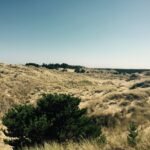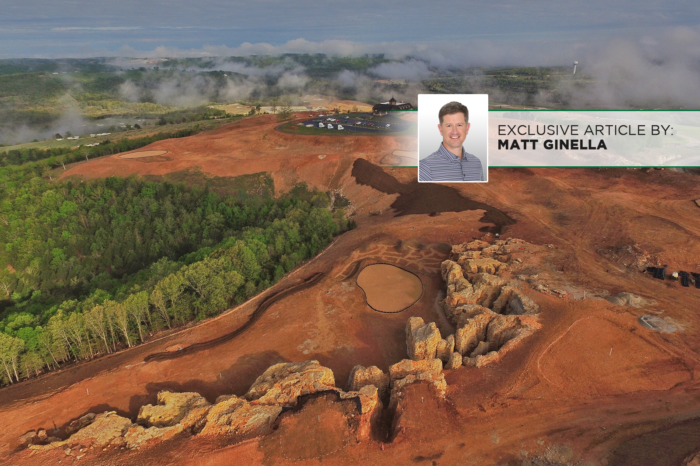“They” say golf is struggling.
Struggling to do what, exactly? I’ve just spent the last few days connecting with 12 of the best public golf destinations in America. The only thing they seem to be struggling with is keeping up with the enhanced demands of the avid amateur. Let’s face it, “we” are spoiled. As “we” should be. Golf remains time consuming, difficult and pricey. And in this great jump ball for our golf dollars, they should all be on their A-games.
Per my travels and as far as I can tell, the ancillary benefits of the economic bubble burst is a little natural selection, a heightened focus on pace of play, the restoration and embrace of municipal golf courses, a separation and identification of thoughtful and talented architects, a movement to simplify the rules, budding grow-the-game initiatives, smart talk of resources and sustainability, a new appreciation and development of the junior caddie and as you’ll read below, a competition at the top properties that is breeding excellence. (And continues to put pressure on private clubs.)
Pebble Beach
It’s not easy getting to No. 1. And it’s even harder to stay there. See Rory McIlroy and/or Jordan Spieth. But Pebble Beach seems poised for an extended stay as the best public course in the country.

In the midst of a five-year plan for golf course updates, the Pebble Beach Company has completed tweaks to the ninth, 17th and 14th greens. They’ve also restored an old 10th tee that hangs over the beach. And according to RJ Harper, Executive Vice President of Golf and Retail, the 13th green is next. “Right now, in championship conditions, the right side of the green is too severe,” said Harper. “We will soften that side of the green and create more pin placements.” As far as when that work will be done, Harper says they will decide by the end of the year.
Even more extensive than the work on the course, Pebble Beach just completed phase one of room renovations. “Every room to the right side of the 18th fairway has been redone,” said Harper. “Exterior. Interior. Everything. And we’re very proud of the work that’s been done there.” Those rooms reopened in April to rave reviews.
And to the left of the first fairway, work continues on Fairway 1, which is a 38-room project that will be finished in July of next year. Thirty of the rooms will be exactly like what’s on the 18th fairway. Two of the “rooms” will be four-bedroom suites with 1,000 square feet of common space. “We never had that before,” said Harper. “We will now have the lodging option for foursomes of friends or four couples.”
As for Pebble’s “little” brother, Harper says Spyglass will get a little longer. But here’s the good news: In March, the 50-year lease of the Spyglass Founders Club expired, resulting in a 30-percent increase in available tee times to the general public. Worth noting and appreciating Spyglass wouldn’t exist without the financial support of those original 250 members ($2,500 each, plus $50 in annual dues for 50 years).
No exterior changes to the Inn at Spanish Bay, but Harper says there are plans to update all rooms at one of my favorite golf hotels in America.
“When the current ownership made the purchase in ’99, their simple goal was to keep improving,” said Harper. “They’ve done nothing but fulfilled that commitment. And will continue to do so.” That ownership includes Arnold Palmer, Richard Ferris, Peter Ueberroth, Clint Eastwood, William Perocchi and GE Pension.
Pebble Beach and Spyglass will host the 2018 U.S. Amateur and Pebble Beach will host the U.S. Open in 2019 as part of their 100-year anniversary celebration.
Bandon Dunes

The sixth course at Bandon Dunes should still be Tom Doak’s 11-hole par-3 course, which will meander through the dunesland near the start of Bandon Trails. From the second tee at Trails you can see at least one flagstick indicating the spot for a proposed green. “We continue to weigh various options,” said Josh Lesnik, President of Kemper Sports, “but unfortunately it doesn’t look like Tom will start building the course this winter.” Doak should break ground in the first or second quarter of 2017.
Meanwhile, Gil Hanse is everywhere. From Rio, Doral, Winged Foot, Mossy Oak and Streamsong Black, but there have also been several Gil Hanse sightings at Bandon Dunes and Pinehurst. More on Pinehurst later, but Mike Keiser has been trying to get a Hanse addition to his Oregon portfolio for over 10 years. A diligent and patient Keiser finally walked away from a decade worth of stalled negotiations with Oregon’s State Park Department and the Bureau of Land Management that would’ve allowed for at least 27 more memorable holes 20 minutes south of the resort. At that same location, Keiser in fact owns enough land for 18, and Hanse has done at least one routing, but there’s also speculation that Hanse might get a crack at some land north of the resort. Sheep Ranch? It’s possible. Either way, the Hanse-working-for-everyone-BUT-Mike Keiser phenomenon will soon come to an end.
Pinehurst
From the purchase of two courses/competitors (2011 & 2014), the gutsy restoration of No. 2 (2011) and successful back-to-back Men’s and Women’s U.S. Opens (2014), Pinehurst’s fairly new President, Tom Pashley, who took over for Don Padgett in late-2014, has snuggled into The Cradle of American Golf at a time when the basinet is on the up swing. So, to keep the momentum going, Pashley just debuted The Deuce, a new open bar that extends onto the porch overlooking No. 2’s 18th green. “The post-round experience now matches the on-course experience,” said Pashley. “The Deuce was built to be the perfect place for golfers to reflect and unwind after a day on the links.”

Pinehurst will host the 2017 U.S. Amateur Four-Ball, 2019 U.S. Amateur and 2024 U.S. Open. No shock if the USGA decides to go back-to-back again with the men’s and women’s major. Everyone agreed it was a strategic, competitive, logistical and financial success.
We also know Coore and Crenshaw have a routing on what once was The Pit Golf Links, which is a few miles off property and, if completed, would be Pinehurst No. 10. But lots of friends and Twitter followers are also reporting Gil Hanse sightings in the Sandhills of North Carolina. Pashley will only say that there’s a lot of potential for a guy like Hanse to help continue the aforementioned momentum of the storied resort.
Anyone for a beer at The Deuce where we can reflect on the possibilities?
Sea Island
And then there was one. Owner, that is.
In case you missed it, Sea Island has been around since 1928, owned and operated by the Jones family. Well, back in 2007, right before the economic crash, Bill Jones III pushed all in on almost $1 billion in upgrades and acquisitions.
Cut to 2010, when two teams of two partners are at an auction, bidding against each other for all that was Sea Island. They paused the auction, huddled, and decided to stop the bidding and own it together. (Among other things, they got the Cloister, Lodge, three courses and a 360-degree driving range with a prime ocean view for $212 million.) Captain Obvious: “They got a great deal.”
In June, the Anschutz family of Denver, CO., one of the four owners, bought out the three other partners and put the property into a 100-year family trust.
So after all that, Sea Island is back to being a family-owned operation with a seemingly endless future.
In April, Sea Island opened another 63 rooms to an extended wing of the Cloister. I’m told the Anschutz family, who also owns The Broadmoor in Colorado Springs, will be looking to make updates and upgrades to all three courses at Sea Island: Seaside (Tom Fazio), Plantation (Rees Jones) and Retreat (Davis and Mark Love). They’re also looking at the property near the back of the range as potential for further development.
American Club, Kohler, WI
With David Kohler’s ongoing focus on addressing the needs and demands of the prototypical four- to 24-person buddies trip, Destination Kohler will break ground this month on an expansion to the Inn at Woodlake, which will include four- to six-person suites. There will be six suites with four bedrooms and four suites with two bedrooms, which will have common living space and kitchenettes. The expansion should be open for bookings later in the 2017 season.
As for the plans of a fifth Pete Dye course, the process of permitting and politics continues. “I wish I had more information,” said a Kohler spokesperson.
(So do we.)
The Greenbrier, White Sulphur Springs, WV
As you recall, historic floods in June devastated West Virginia, causing 15 deaths in Greenbrier County and 23 statewide. The 235-year-old resort cancelled their PGA Tour event and opened its doors to flood victims. And in less than three weeks, the 710-room hotel reopened to the public. Almost all of the golf on property needed more time.
“It has been organized chaos here,” said Burt Baine, Greenbrier’s Director of Golf. “We have four courses under major construction, all within five miles of each other.” Baine noted that Kelly Schumate, the Director of Golf Course Maintenance for all four courses, hasn’t had a day off since June 23. (Which is 83 days, and counting…)
The Greenbrier Course suffered the least amount of damage and reopened in mid-July.
Old White TPC at The Greenbrier, a C.B. Macdonald and Seth Raynor original, will remain shut down and is undergoing a complete restoration by Keith Foster, who has previously restored prominent courses such as Philadelphia Cricket Club, Southern Hills and Eastward Ho!
“There will be no major changes,” said Baine. “But Keith’s going to uncover a lot of cool stuff out there. And the greens will get a necessary consistency.”
Blaine expects the new Old White to reopen for next year’s Greenbrier Classic (July 3—9). The Meadows course is scheduled to reopen in late-April.
The Sam Snead course, a private Tom Fazio design, was hit the hardest. The course remains closed while Fazio’s team redoes all greens, bunkers and the design of three holes.
The “Big Course,” which is being designed by Nicklaus, Palmer, Player and Trevino, is underway. And although early indications were that Team Nicklaus would be doing a bulk of the design and work, that’s apparently not true. According to Baine, it has been a fairly balanced collaboration. And although Trevino might not have as much experience in architecture, he has always been a plus-six storyteller, which goes a long way to getting people to see the finished product. Trevino has been a pro-emeritus at the Greenbrier since 2015 and has already spent several months on site engaging and entertaining guests and golfers.
“One thing we’ve realized in this summer of very little golf,” said Baine, “is that, going forward, we will get focused on repositioning the Greenbrier as a golf destination. It has been very obvious the last few months that golf drives a bulk of what goes on at this resort.”
Big Cedar Lodge

Owner, Johnny Morris, doesn’t just keep turning sinkholes into spectacular cave tours. The founder of Bass Pro Shops is also turning the Ozarks into a golf heaven. He has an Arnold Palmer driving range, a Jack Nicklaus short course and a Tom Fazio championship course. He’s opening a Gary Player 12-hole par-3 course in 2017 and a Coore and Crenshaw 18-hole course in 2018. Morris also continues to make updates and enhancements to the resort he purchased in 1987.



























